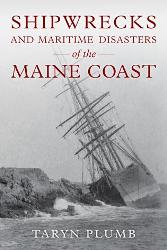 Pirates and Privateers Pirates and Privateers
The History of Maritime
Piracy
Cindy Vallar, Editor
& Reviewer
P.O. Box 425,
Keller, TX 76244-0425
    
Books for
Adults ~ Disasters, Mutinies, & Shipwrecks

Shipwrecks and Other Maritime
Disasters of the Maine Coast
by Taryn Plumb
Down East Books, 2021, ISBN 978-1-60893-724-0, US $18.95
    
Shipwrecks
fascinate us. They stir our curiosity, raising
questions, some of which can never be answered. The
first is unknown, although the oldest one found
dates to 400 BC. They are evidence that no matter
how hard we try to tame the ocean, powerful forces
disabuse us of this. We still continue to try.
Shipbuilding, trade, and travel have long been tied
to Maine’s history, yet the state’s coastal waters
are also the final resting place for many vessels.
One thousand six hundred are documented, but we may
never know the full count because prior to 1874, it
wasn’t necessary to report such sea disasters and
witness accounts don’t always agree. The 3,500 miles
of shoreline are treacherous, with many hidden
dangers, and the names of offshore islands – Deadman
Ledge, Devil’s Island, Hell Gate, Burial Island –
portend this peril. Then there are the structural
failures, human error, man-made dangers, and whims
of Mother Nature that are also responsible for
endangering lives and ships that venture near these
shores.
An integral part of the history of shipwrecks is
man’s attempts to prevent them. The first lighthouse
in Maine begins operating in 1791. The US
Life-Saving Service, a forerunner of the US Coast
Guard, helps rescue crew, passengers, and property
beginning in 1848. The seventeen chapters of this
book recount “stories of tragedy and triumph, loss
and salvation, [and] can serve as cautionary tales
and reminders of the sea’s mighty dominance and
will.” (xv)
Following her introduction, Plumb shares the
earliest account of a Maine shipwreck, which
Governor William Bradford of Plymouth Colony records
in 1624. Plumb also chronicles losses during the
Great Colonial Hurricane of 1635, and the story of James,
which finds herself in the midst of a hurricane.
Among her passengers is the Reverend Richard Mather,
whose offspring will become famous Boston
theologians.
Plumb writes a history of shipwrecks and other
maritime disasters that is at times gripping, at
times hopeful, and often poignant. Those familiar
with Maine’s history may be familiar with many of
these tales, such as that of Katherine Bright who
keeps the light on Boon Island burning for five days
after a storm kills her husband, or the Penobscot
Expedition during the Revolutionary War, which ranks
as the US Navy’s worst defeat until Pearl Harbor, or
the 1813 battle between HMS Boxer and USS Enterprise,
in which both captains die. Many readers, however,
are introduced to new accounts of cannibalism,
heroism, deplorable exploitation, puzzling
disappearances, ghosts, nightmares foretelling doom,
frozen lovers, a concrete ship, and a German U-boat
on the hunt. There’s even the story of Royal Tar,
an early steamship that catches fire while
transporting a circus.
This is a worthy addition to any maritime
collection. A list of sources is provided, and
although there is no index, the recounting of
shipwrecks and disasters unfold mostly in
chronological order. A great, yet haunting, read on
a dark and stormy night.
Review
Copyright ©2021 Cindy Vallar

Click to contact me
Background image compliments
of Anke's Graphics |

